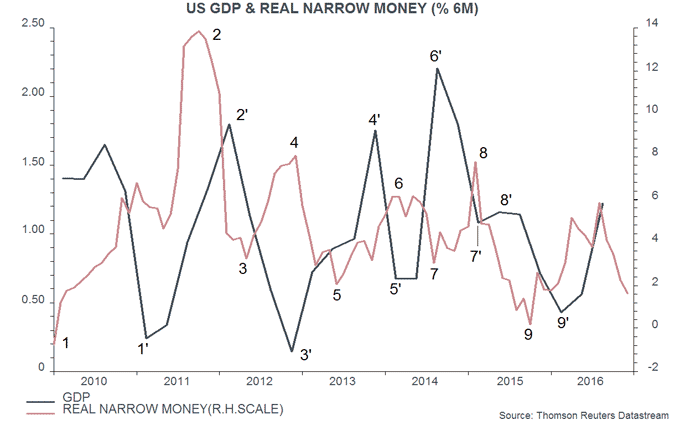Entries from January 1, 2017 - January 7, 2017
US money trends at odds with consensus economic optimism
US narrow money trends weakened further in December, strengthening the conviction here that the economy will lose momentum from around spring 2017, in turn casting doubt on the average expectation of Federal Open Market Committee (FOMC) participants for a 75 basis point rise in official rates during 2017.
Swings in real (i.e. consumer price inflation-adjusted) narrow money growth have consistently led fluctuations in GDP expansion in recent years (and over the longer term) – see chart. Current economic strength reflects a surge in six-month real money growth to a peak in August 2016. The loss of monetary momentum since then echoes a sharp slowdown over the summer / autumn of 2015, which preceded weak GDP outcomes in winter 2015 / spring 2016. 
The final real money growth data point in the chart is a December estimate based on weekly monetary data through 26 December and an assumed 0.2% monthly rise in seasonally-adjusted consumer prices.
Monetary changes usually lead activity swings by between six and 12 months, with an average of nine months. The August 2016 peak in six-month real narrow money growth suggests that two-quarter GDP momentum will top out in the second quarter of 2017, plus or minus one quarter.
Any slowdown is expected here to be less pronounced than in late 2015 / early 2016 because 1) money trends are not as weak now as then and 2) the Kitchin stockbuilding cycle was entering a downswing phase in late 2015 but appears to have bottomed in 2016.
The obvious counter-argument to a slowdown forecast is that fiscal stimulus will boost growth in the second half of 2017 and 2018. The effects of fiscal policy, however, should be incorporated in narrow money trends: shifts in money demand are largely driven by changes in spending intentions of households and firms, which would strengthen in response to an effective fiscal stimulus. If the counter-argument is correct, that is, real money growth should rebound in early 2017. Even if it does, the recent pull-back suggests a softer patch for the economy around mid-2017.
UK money trends cooling
UK monetary trends remained solid in the immediate aftermath of the Brexit vote but November numbers released today were weak, suggesting deteriorating economic prospects for mid-2017, allowing for an average nine-month lead from money to activity.
The preferred narrow and broad money measures here are non-financial M1 / M4, comprising holdings of households and private non-financial corporations (PNFCs). Both aggregates grew by only 0.1% in November – the weakest monthly changes since 2011-12.
Annual growth of non-financial M1 fell to 9.4% in November, a five-month low and down from a September peak of 10.2%. Annual non-financial M4 growth retreated to 5.7%, the lowest since December 2015, having reached 6.8% in September.
Economic growth prospects are related to real (i.e. inflation-adjusted) monetary trends. The first chart shows six-month rates of change of non-financial M1 / M4 deflated by consumer prices (seasonally adjusted). The nominal money slowdown has been compounded by accelerating consumer prices, which rose at a 1.9% annualised pace in the six months to November. Six-month real narrow money growth is at a 14-month low, with real broad money expansion the weakest since August 2014.
As the chart shows, faster real money growth in 2015 / early 2016 was reflected in a pick-up in two-quarter GDP momentum through the third quarter of 2016. Real money trends remained solid until autumn 2016, suggesting that economic strength will be sustained until spring 2017. The November numbers, however, hint at a sharp slowdown over the summer.
Monthly monetary statistics can be volatile so it is probably advisable to wait for December data before concluding that the economic outlook is darkening.
The recent fall in six-month real non-financial M1 growth reflects fading strength in the household component, which correctly signalled consumer spending resilience before and after the Brexit vote but now suggests rising caution – second chart. Corporate narrow money trends, by contrast, remain stable and solid, possibly indicating that Brexit worries have so far been neutralised by a better-than-expected economic environment.
The narrow money numbers have probably been slightly depressed recently by a switch of funds out of bank deposits into National Savings products – particularly instant-access income bonds, yielding a competitive 1.0%. National Savings inflows totalled £2.2 billion in November, equivalent to 0.2% of non-financial M1.



